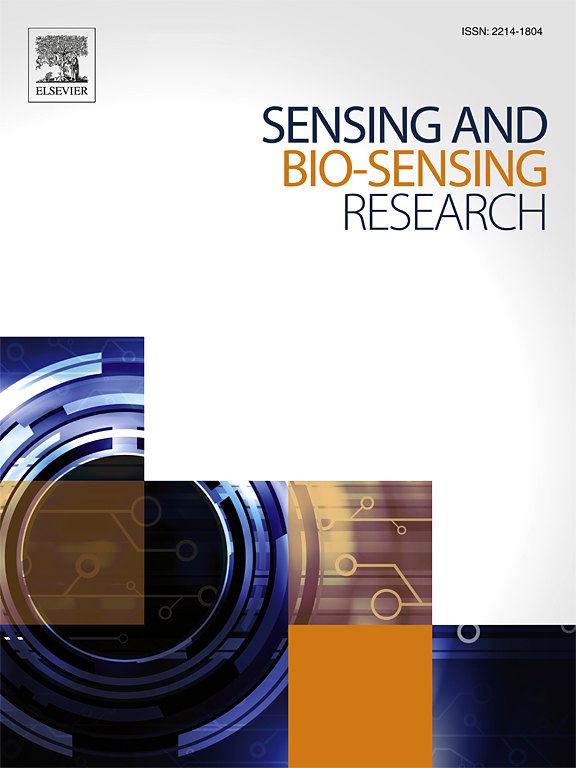Prototyping an internet-of-things-based bioacoustics system to support research and surveillance of avian-associated infectious diseases
IF 4.9
Q1 CHEMISTRY, ANALYTICAL
引用次数: 0
Abstract
Zoonotic infectious diseases and cross-species pathogen spillover are driven by biodiversity and spatio-temporal ecological interactions. Generating high-resolution data to approximate the presence and absence of animals and their mobility, density, and interactions can enhance research efforts and improve public and veterinary health prediction capacities. Bioacoustics technology provides solutions for tracking vocalizing animals in space and time, contributing to infectious disease ecology research. We report on our adaptation and testing of a bioacoustics Internet-of-Things system for passive spatio-temporal monitoring of avian species, situating its application within the context of zoonoses. We tested alternatives for the physical sensor device, microphones, and battery and chose Raspberry Pi Zero 2 W as our base computer. We further embedded and configured machine learning (ML) classification algorithms building on the BirdNET-Pi for avian classification. We developed a software, that supports TensorFlow-based classification algorithms and facilitates easy and open uploads of alternative ML algorithms for non-avian taxa (faunanet) for future applications of the prototype for multi-species bioacoustics monitoring. We evaluated the performance of the physical system and validated its classification accuracy within the premises of a zoo. Across four field tests, we collected 700 h of audio data on avian vocalizations and identified 57 distinct species. The performance of the prototype depends on the parametrization of the classification algorithms and the positioning of the physical sensor. Overall, the developed prototype demonstrated that the system can be further piloted for studies on zoonotic infectious diseases.
基于物联网的生物声学系统原型,以支持与禽类相关的传染病的研究和监测
人畜共患传染病和跨物种病原体溢出是生物多样性和时空生态相互作用的结果。生成高分辨率数据,以估计动物的存在和不存在及其流动性、密度和相互作用,可以加强研究工作,提高公共和兽医卫生预测能力。生物声学技术提供了在空间和时间上跟踪发声动物的解决方案,有助于传染病生态学的研究。我们报告了一种生物声学物联网系统的适应和测试,用于鸟类物种的被动时空监测,并将其应用于人畜共患病的背景下。我们测试了物理传感器设备、麦克风和电池的替代品,并选择了Raspberry Pi Zero 2w作为我们的基础计算机。我们在BirdNET-Pi的基础上进一步嵌入和配置机器学习(ML)分类算法,用于鸟类分类。我们开发了一个软件,该软件支持基于tensorflow的分类算法,并为非鸟类分类群(faunanet)的替代ML算法提供了方便和开放的上传,以用于未来多物种生物声学监测的原型应用。我们评估了物理系统的性能,并在动物园的前提下验证了其分类准确性。通过四次实地测试,我们收集了700小时的鸟类发声音频数据,并确定了57种不同的物种。原型的性能取决于分类算法的参数化和物理传感器的定位。总的来说,开发的原型表明该系统可以进一步用于人畜共患传染病的研究。
本文章由计算机程序翻译,如有差异,请以英文原文为准。
求助全文
约1分钟内获得全文
求助全文
来源期刊

Sensing and Bio-Sensing Research
Engineering-Electrical and Electronic Engineering
CiteScore
10.70
自引率
3.80%
发文量
68
审稿时长
87 days
期刊介绍:
Sensing and Bio-Sensing Research is an open access journal dedicated to the research, design, development, and application of bio-sensing and sensing technologies. The editors will accept research papers, reviews, field trials, and validation studies that are of significant relevance. These submissions should describe new concepts, enhance understanding of the field, or offer insights into the practical application, manufacturing, and commercialization of bio-sensing and sensing technologies.
The journal covers a wide range of topics, including sensing principles and mechanisms, new materials development for transducers and recognition components, fabrication technology, and various types of sensors such as optical, electrochemical, mass-sensitive, gas, biosensors, and more. It also includes environmental, process control, and biomedical applications, signal processing, chemometrics, optoelectronic, mechanical, thermal, and magnetic sensors, as well as interface electronics. Additionally, it covers sensor systems and applications, µTAS (Micro Total Analysis Systems), development of solid-state devices for transducing physical signals, and analytical devices incorporating biological materials.
 求助内容:
求助内容: 应助结果提醒方式:
应助结果提醒方式:


